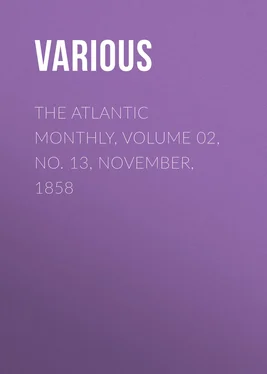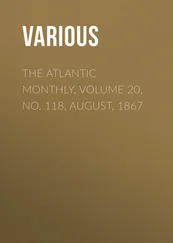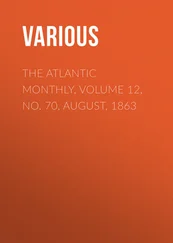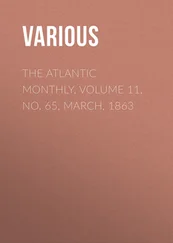Various - The Atlantic Monthly, Volume 02, No. 13, November, 1858
Здесь есть возможность читать онлайн «Various - The Atlantic Monthly, Volume 02, No. 13, November, 1858» — ознакомительный отрывок электронной книги совершенно бесплатно, а после прочтения отрывка купить полную версию. В некоторых случаях можно слушать аудио, скачать через торрент в формате fb2 и присутствует краткое содержание. Жанр: foreign_antique, periodic, foreign_edu, на английском языке. Описание произведения, (предисловие) а так же отзывы посетителей доступны на портале библиотеки ЛибКат.
- Название:The Atlantic Monthly, Volume 02, No. 13, November, 1858
- Автор:
- Жанр:
- Год:неизвестен
- ISBN:нет данных
- Рейтинг книги:4 / 5. Голосов: 1
-
Избранное:Добавить в избранное
- Отзывы:
-
Ваша оценка:
- 80
- 1
- 2
- 3
- 4
- 5
The Atlantic Monthly, Volume 02, No. 13, November, 1858: краткое содержание, описание и аннотация
Предлагаем к чтению аннотацию, описание, краткое содержание или предисловие (зависит от того, что написал сам автор книги «The Atlantic Monthly, Volume 02, No. 13, November, 1858»). Если вы не нашли необходимую информацию о книге — напишите в комментариях, мы постараемся отыскать её.
The Atlantic Monthly, Volume 02, No. 13, November, 1858 — читать онлайн ознакомительный отрывок
Ниже представлен текст книги, разбитый по страницам. Система сохранения места последней прочитанной страницы, позволяет с удобством читать онлайн бесплатно книгу «The Atlantic Monthly, Volume 02, No. 13, November, 1858», без необходимости каждый раз заново искать на чём Вы остановились. Поставьте закладку, и сможете в любой момент перейти на страницу, на которой закончили чтение.
Интервал:
Закладка:
Of the whole cost of working a railroad about one third is chargeable to the locomotive department; from which it is plain that the most proper adaptation is well worth the careful attention of the engineer. Though it is generally considered that the proper person to select the locomotive power can be none other than a practical machinist, and though he would doubtless select the best workmanship, yet, if not acquainted with the general principles of locomotion, and aware of the character of the road and of the expected traffic, and able to judge, (not by so-called experience, but by real knowledge,) he may get machinery totally unfit for the work required of it. Indeed, American civil engineers ought to qualify themselves to equip the roads they build; for none others are so well acquainted with the road as those who from a thorough knowledge of the matter have established the grades and the curvatures.
The difference between adaptation and non-adaptation will plainly be seen by the comparison below. The railway from Boston to Albany may be divided into four sections, of which the several lengths and corresponding maximum grades are as tabulated.
Boston to Worcester, 44 30
Worcester to Springfield, 541/2 50
Springfield to Pittsfield, 52 83
Pittsfield to Albany, 431/2 45
A load of five hundred tons upon a grade of thirty feet per mile requires of the locomotive a drawing-power of 11,500 lbs.
Upon a 50 feet grade 15,500 lbs.
Upon an 83 feet grade 22,500 lbs.
Upon a 45 feet grade 14,500 lbs.
Now, if the engines are all alike, (as they are very nearly,) and each is able to exert a drawing-power of five thousand pounds to move a load of five hundred tons from Boston to Albany, we need as follows:
B. to W.—11500/5000 or 2 engines.
W. to S.—15500/5000 or 3 engines.
S. to P.—22500/5000 or 5 engines.
P. to A.—14500/5000 or 3 engines.
From which the whole number of miles run by engines for one whole trip would be,—
B. to W. 44 miles by 2 engines, or 88
W. to S. 541/2 miles by 3 engines, or 1631/2
S. to P. 52 miles by 5 engines, or 260
P. to A. 491/2 miles by 3 engines, or 1481/2
______
And the sum, 660
Now suppose, that, by making the engines for the several divisions strong in proportion to the resistance encountered upon these divisions, one engine only is employed upon each; our mileage becomes,
B. to W. 44 by 1 or 44
W. to S. 541/2 by 1 or 541/2
S. to P. 52 by 1 or 52
P. to A. 49 by 1 or 491/2
_____
And the sum, 200 miles.
And the saving of miles run is therefore 660 less 200, or 460; and if 500 tons pass over the road daily, the annual saving of mileage becomes 460 by 313, or 143,980, or 70 per cent. of the whole. The actual cost for freight-locomotives per ton, per mile run, during the year ending Sept. 30, 1855, was 384/1000 of a cent; and the above 143,980 miles saved, multiplied by this fraction, amounts to $55,288 per annum. The actual expense of working the power will not of course show the whole 70 per cent. of saving, as heavy and strong engines cost more at first, and cost more to operate, than lighter ones; but the figures show the effect of correct adaptation. If we call the saving 50 per cent. only of the mileage, we have then (as the locomotive power consumes 30/100 of the whole cost of operating) 50/100 of 30/100, or 15/100, of the whole cost of working the road, and this by simply knowing how to adapt the machinery to the requirement.
So very slight are the points of difference between a good and a bad engine, that they often escape the eye of those whose business it is to deal with such works. It is not the brass and steel and bright metal and elaborate painting that make the really good and serviceable engine,—but the length, breadth, and depth of its furnace, the knowledge of proportion shown in its design, and the mechanical skill exhibited in the fitting of its parts. The apparently complex portions are really very simple in action, while the apparently simple parts are those where the greatest knowledge is required. Any man of ordinary mechanical acquirements can design and arrange the general form,—the whole mass of cranks, pistons, connecting-rods, pumps, and the various levers for working the engine; but to find the correct dimensions of the inner parts of the boiler, and of the valve-gearing, by which the movements of the steam are governed, requires a very considerable knowledge of the chemistry of combustion, of practical geometry, and of the physical properties of steam. So nice, indeed, is the valve-adjustment of the locomotive, as depending upon the work it has to do, whether fast or slow, light or heavy, that a single eighth of an inch too much or too little will so affect its power as to entirely unfit it for doing its duty with any degree of economy.
When a single man takes the general charge of five hundred miles of railroad, upon which the annual pay-roll is a million of dollars, and which employs over two hundred locomotives and three thousand cars, earning five million dollars a year,—a road which cost thirty-three million, has five miles in length of bridges, and over four hundred buildings,—it is plain that the system of operation must be somewhat elaborate. And so it is. Indeed, so complete is the organization and management of employées upon the New York and Erie Railroad, that the General Superintendent at his office can at any moment tell within a mile where each car or engine is, what it is doing, the contents of the car, the consignor and consignee, the time at which it arrives and leaves each station, (the actual time, not the time when it should arrive,) and is thus able to correct all errors almost at the moment of commission, and in reality to completely control the road.
The great regulator upon long lines of railroad is the electric telegraph, which connects all parts of the road, and enables one person to keep, as it were, his eye on the whole road at once.
A single-track railroad, says Mr. McCallum, may be rendered more safe and efficient by a proper use of the telegraph than a double-track railroad without,—as the double-tracks commonly obviate collisions which occur between trains moving in opposite directions, whilst the telegraph may be used effectually in preventing them between trains moving either in opposite directions or in the same direction; and it is a well-established fact, deduced from the history of railroads both in Europe and in this country, that collisions from trains moving in the same direction have proved by far the most fatal and disastrous, and should be the most carefully guarded against.
From the admirable report of Mr. McCallum, above referred to, we take the following:—Collisions between fast and slow trains moving in the same direction are prevented by the following rule: 'The conductor of a slow train will report himself to the Superintendent of Division immediately on arrival at a station where, by the time-table, he should be overtaken by a faster train; and he shall not leave that station until the fast train passes, without special orders from the Superintendent of Division.' A slow train, under such circumstances, may, at the discretion of the Division Superintendent, be directed to proceed; he, being fully apprised of the position of the delayed train, can readily form an opinion as to the propriety of doing so; and thus, while the delayed train is permitted to run without regard to the slow one, the latter can be kept entirely out of its way.
"The passing-place for trains is fixed and determined, with orders positive and defined that neither shall proceed beyond that point until after the arrival of the other; whereas, in the absence of the telegraph, conductors are governed by general rules, and their individual understanding of the same,—which rules are generally to the effect, that, in case of detention, the train arriving first at the regular passing-place shall, after waiting a few moments, proceed cautiously (expecting to meet the other train, which is generally running as much faster, to make up lost time, as the cautious train is slower) until they have met and passed; the one failing to reach the half-way point between stations being required to back,—a dangerous expedient always,—an example of which operation was furnished at the disaster on the Camden and Amboy Railroad near Burlington; the delayed train further being subjected to the same rule in regard to all other trains of the same class it may meet, thus pursuing its hazardous and uncertain progress during the entire trip."
Читать дальшеИнтервал:
Закладка:
Похожие книги на «The Atlantic Monthly, Volume 02, No. 13, November, 1858»
Представляем Вашему вниманию похожие книги на «The Atlantic Monthly, Volume 02, No. 13, November, 1858» списком для выбора. Мы отобрали схожую по названию и смыслу литературу в надежде предоставить читателям больше вариантов отыскать новые, интересные, ещё непрочитанные произведения.
Обсуждение, отзывы о книге «The Atlantic Monthly, Volume 02, No. 13, November, 1858» и просто собственные мнения читателей. Оставьте ваши комментарии, напишите, что Вы думаете о произведении, его смысле или главных героях. Укажите что конкретно понравилось, а что нет, и почему Вы так считаете.












